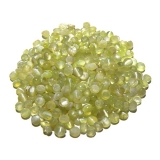Chrysoberyl Cat's Eye
The mineral Chrysoberyl is the third hardest natural mineral on Earth (after Diamond and Corundum). As a reason, it has a history of having been used as a gemstone. The dominant colours of chrysoberyl are green/yellow and brown. Although its name resembles beryl, the two have completely different optical and physical properties.
What is a Chrysoberyl Cat’s Eye?
 Many gems exhibit the optical effect called Chatoyancy or Cat’s Eye Effect which is seen when the gemstone is cut en cabochon. They display a single ray of line which runs across the surface of the stone and moves as the stone is rotated in one direction. This cat’s eye effect is seen because of parallel inclusions of tubes/fibers inherent in the stone. Only in case of Chrysoberyl can the term Cat’s Eye be used without any prefix. In all other cases, the term cat’s eye has to be put only after the name of the stone i.e. Quartz cat’s eye, Iolite cat’s eye etc. Chrysoberyl cat’s eye is also referred to as Cyamophane.
Many gems exhibit the optical effect called Chatoyancy or Cat’s Eye Effect which is seen when the gemstone is cut en cabochon. They display a single ray of line which runs across the surface of the stone and moves as the stone is rotated in one direction. This cat’s eye effect is seen because of parallel inclusions of tubes/fibers inherent in the stone. Only in case of Chrysoberyl can the term Cat’s Eye be used without any prefix. In all other cases, the term cat’s eye has to be put only after the name of the stone i.e. Quartz cat’s eye, Iolite cat’s eye etc. Chrysoberyl cat’s eye is also referred to as Cyamophane.
What quality is considered best for a Chrysoberyl Cat’s Eye?
In general, the color of a Chrysoberyl Cat’s Eye ranges from yellowish brown to pale yellow. It can also be grass green in colour or greenish yellow. However the most sought after shade is considered to be the rare honey color. In case of Chrysoberyl Cat’s Eye, as is with any other cat’s eye, the most important factor to influence pricing is the line of the cat’s eye. A strong and thin line is prized more than a line which is dull, or very thick. Also, the line should reach to the ends of the dome shape otherwise the price diminishes considerably. A cat’s eye along the longer side of the stone is more desirable than cat’s eye which is along the shorter side.
The most valuable Chrysoberyl Cat’s Eye is the Alexandrite Cat’s Eye which changes colour when viewed in different lights (it appears green in daylight and red under incandescent source of light).
How do I identify a Chrysoberyl Cat’s Eye from other Cat’s Eye?
Chrysoberyl essentially is a beryllium aluminium oxide. The density of Chrysoberyl is much more than any of the normal cat’s eye (it has a specific gravity of 3.71 to 3.80 while most of the other cat’s eye have a specific gravity of less than 3.32). Hence, immersion in a chemical such as Di-iodomethane would make the Chrysoberyl Cat’s Eye float while all other cat’s eye would sink. Another less expensive test is the hardness test. Chrysoberyl has hardness of 8.5 on Moh’s scale of hardness hence it would scratch a piece of glass deep and hard as compared to any other cat’s eye. A Chrysoberyl can also not be scratched by any material except corundum (ruby/sapphire) and diamond.
How is a Chrysoberyl Cat’s Eye cut?
A Chrysoberyl Cat’s Eye needs to be cut en cabochon to display its optical properties. Even then, it is essential that the stone is cut with the parallel sets of inclusions running parallel to the base of the cabochon in order to have a well-centered ray. Also, the stone should be cut in such a way that the parallel inclusions should be perpendicular to the longer side of the stone i.e. in case of oval shapes the inclusions should be perpendicular to the longer side which would display a cat’s eye along the longer side of the oval.
Chrysoberyl Cat's Eye Gems from our Inventory










